The story of the creation of Norton Commander. Part 1/3
Drunk programmer sits with open Norton Commander on the screen. On both panels, drive C is open. “Well, why do I need two drive C with the same files?” He thought and erased all its contents by pressing F8 and Enter.- a joke of the late 80s
Norton Commander for DOS is a file manager for DOS that existed in 5 major versions - 1.0, 2.0, 3.0, 4.0, 5.0, and only the latest version has a subversion of 5.5. Many versions are still used by various enthusiasts and are on various sites on the Internet.
This was perhaps one of the most popular file managers in the era of the DOS operating system, which along with XTree broke with its roots in DOS and in the form of other programs that inherited its functionality that exist on other operating systems.
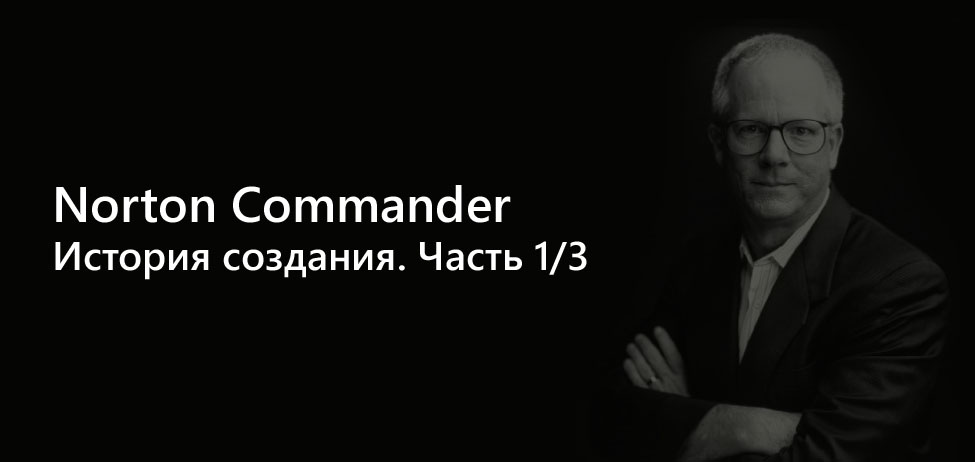
The first version of NC 1.0 was developed by John Socha (Jonh Socha) in 1984-1989.
Starting with version 2, Norton Commander has achieved success comparable to that of 123, WordPerfect and MS Word, especially in the former USSR and Eastern Europe, where the Norton Commander blue screen has become synonymous with DOS. Many users never even suspected that this was not the native DOS interface, but in Russian the words "Norton" and "Commander" became part of the IT jargon, and, in fact, became synonymous with the file manager.
Norton Commander was taught in classes at schools and institutes in most countries of the region of the former USSR, as well as at European colleges and universities in eastern countries. This means that all graduates were more or less experienced users of Norton, which was the standard interface for DOS. And I would like to emphasize once again that many people did not even suspect that it was not part of DOS, but simply an additional utility. And the DOS era even influenced the hiring process: the skill of using Norton Commander became associated with the use of the DOS system in the minds of many IT hiring managers.
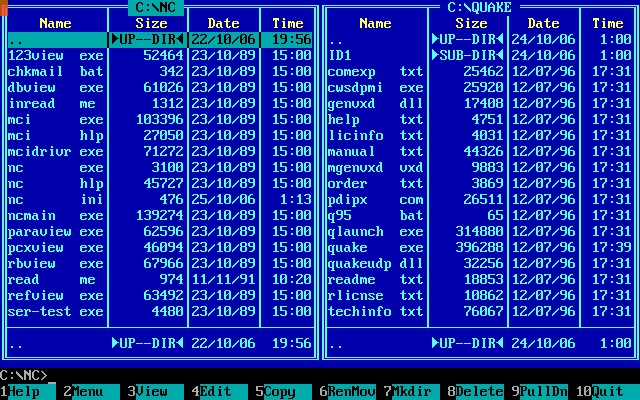
The very first version of the DOS shell was named VDOS (Visual DOS) and was written in a mixture of C and Assembler. As John Socha said, recalling past events:
I started work on what later became known as Norton Commander. In the fall of 1984, when I was still a graduate student in applied physics at Cornell University. The first versions were written entirely in Assembler. But it took too much time, because I soon switched to developing a mixture of C and Assembler, while most "real programmers" did not accept C.
At that time, I called it “Visual DOS” with the abbreviation VDOS instead of the usual two-letter abbreviations that were used at that time. The program itself was inspired by several things put together. Then I had a contract with Microsoft Press, according to which I had to write several books and even spent some time in Bellevue, Washington, while I worked there. Then he took two months of graduate school and wrote a book.
The second book was supposed to be about small utilities that I used to use (for example, whereas, scrnsave, and others). But I did not finish this book because of one utility, which I have spent my whole life writing.
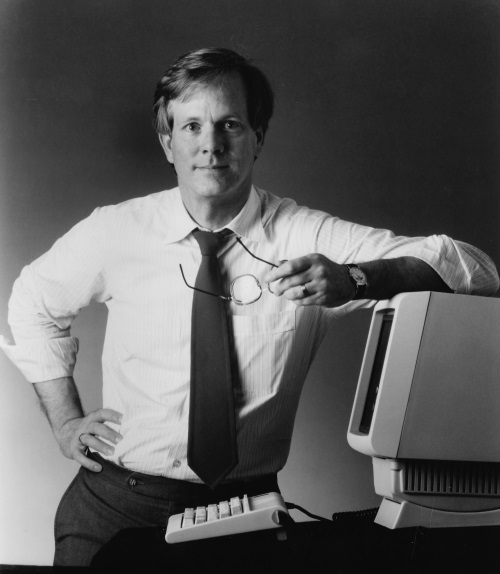
John Socha received both MS and PhD in Applied Physics from Cornell University. After graduation, John became the first director of the research and development department of the now defunct Peter Norton Computing. He was the second programmer at the company and soon hired Brad Kingsberry.
At this time, Peter Norton Computing was a one-man show. It was founded by one of the pioneers of entrepreneurs in the development of commercial software. He set up his first company in 1982 with $ 30,000 and an IBM computer (the company was sold to Symantec for 70 million in 1990). In 1992, Smart Computing, in an article entitled “Investigating The Lost Files Of Peter Norton, PC Pioneer,” Gillian Coolidge wrote:
The story goes that Peter Norton worked in the aerospace industry back in the late 1970s, but he lost his job when Boeing, McDonnell Douglas and Lockheed made massive cuts. To pay bills, Norton began to take part-time jobs under the contract.
Once, Norton accidentally deleted an important file, which was a common and common mistake for everyone. Instead of re-entering all the information, he thought to write a computer program that will recover lost data. This program not only saved the lost file, but ultimately also helped make Peter Norton a very rich, and very famous person.
Norton called his program Norton Utilities ...
It was 1982, and Norton launched the program through his company (which he alone worked for), Peter Norton Computing Inc. (PNCI). And next year, PNCI released the second version of Norton Utilities, which actually consisted of several small utilities that saved the "lost" files and contents of the disk.
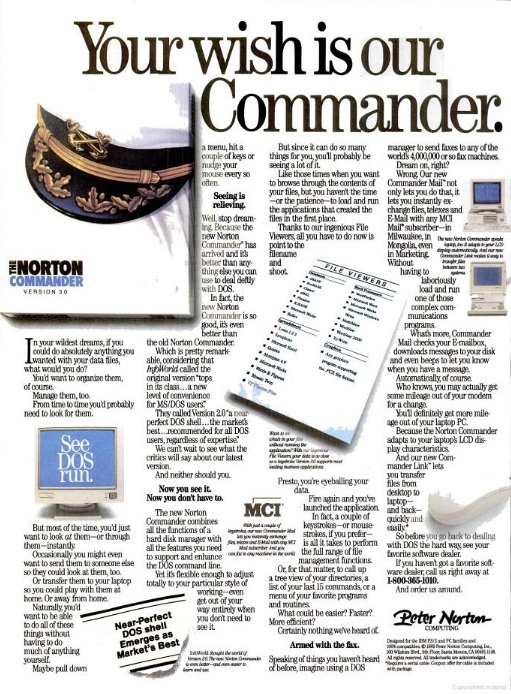
In 1984, PNCI received $ 1M dollars, and also released Norton Utilities version 3. At that time, three people worked for the company. However, Peter was involved in the entire development and writing of books, manuals, and business. It is important to understand that, in fact, the company was a one-man theater with some support staff. Therefore, the income that was received from version 3.0 made an obvious fact: the company needs expansion. Need a programmer. Brad Kingsberry, who authored the NCD utility (which was later integrated into Norton Commander as NCD mode), recalls those days:
I joined Peter Norton Computing in 1985 as the company's first programmer. My previous employer had just closed his doors, so I sent my resume to several companies. Peter answered me and paid for the tickets to Seattle, where he rested on summer vacation, and then hired on the spot. And since Peter was still on vacation, I started work right from the hotel in Seattle and worked from there for the first two weeks. Further, over the next 6 months, I worked with the PNCI kitchen table. When Eileen, the wife of Peter, began to cook dinner, I realized that the working day was over and went home.
... My responsibilities were software development and this is what I did. PNCI now has five employees. Peter was involved in the development, management, marketing, and writing of manuals from the den of his house. And three of his employees worked upstairs.
Peter Norton has always been a laid-back man. His whole philosophy came down to a phrase that I constantly heard from him: "we will be engaged in this business while it's fun." Therefore, the main focus to do something was “cool” or “fun”, and only then - money.
“I never knew what would have happened if we had not made money, but the process itself would have been fun. Perhaps it still would not be so much fun, especially for Peter, ”says Kingsberry. “But he did not seek to create the“ next generation of software, ”and he did not seek to earn a lot of money. It was really fun with him, he loved flexibility and did not like working for someone. ”
PNCI achieved revenue of $ 5 million. In 1986, he published several other software packages, however, according to Peter, Norton's utilities were still a cash cow. They are gaining widespread acceptance, and users have realized the benefits of data recovery.
Peter Norton, in fact, created a new class of software for personal computers: data recovery software. And, since this area was a profitable sector, it became clear that it would begin to attract competitors (PC Tools was the most outstanding). Quoting Peter Norton:
Why have Norton Utilities become such a popular software? Industry wisdom says: software is becoming popular either by providing superior capabilities or by solving problems that were previously not resolved. In 1982, when I sat down on my computer to write Unerase, I was solving a general problem for which there were no solutions.
Peter Norton quickly realized that he had stumbled upon a gold mine and began to do business. That was one of the reasons he hired Kingsberry and Sochi.
PNCI published several versions, each of which was more and more capable for almost a decade of its existence. Peter Norton was also a gifted writer, which was an important part of PR. He also wrote several books. His most influential book was a book co-authored with John Socha and was the best book to study Intel Assembler for more than a decade. By the way, his famous quote: “Assembler language is an extravagant result of the work of human talent and you should avoid it wherever possible,” - from the 1986 edition.
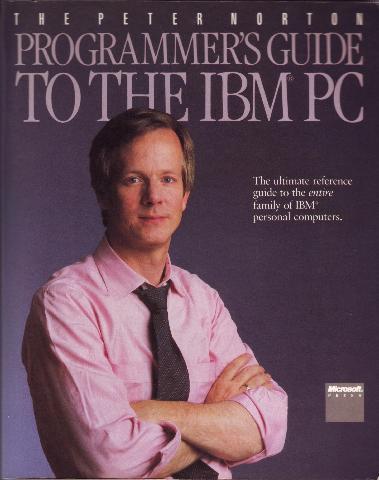
The core of Norton Utilities was the FAT Undelete utility, which allowed you to restore files if their clusters were not overwritten when creating new files. In the FAT system, in order to restore a file, it was enough to restore the first letter of the file name in the directory entry (this feature of the FAT file system was used by the DOS system, but was not documented). After the first release, Peter Norton made Utilities Editor for PC Magazine. The package grew rapidly and the second version (ver. 4, 1986) contained more than 20 utilities (Brad Kingsberry took part in the development, as he was hired in the summer of 1985. He was a talented programmer and made a lot of contribution to the development of utilities. ndd)
- nu , ud (UnRemove directory) and from version 4.0 qu (quick unformat) - a unique set of utilities for recovering files in the FAT file system: “Norton Unility” and a directory recovery utility. One of the first in its class. Later, the innovative innovative method of recovering deleted files in FAT was the key to the successful launch of the company. Quick Unerase (qu) was added in Norton Utilities 4.0
- fr (format Recover). It had to start from autoexec.bat with the / save command line option and wrote a special frecover.dat file to the disk, which created a duplicate of the file system system blocks and allowed to completely restore the file system after the format command.
- sd - the famous Speed Disk - a pioneer in the matter of disk defragmentation and was one of the first utilities for optimizing the file system.
- ncd (Norton Change Directory) was a pioneer in navigating the file system as a hierarchical structure and contained a quick search algorithm. He introduced XTree's quick directory hierarchy search. This utility was first introduced in version 4.0 and was written by Brad Kingsberry
- In later versions, there was also a very interesting utility called Norton Image , which allowed saving critical system blocks to the hard disk for cases when the hard disk was suddenly disconnected or the system blocks would be damaged
- Wipedisk and wipefile - utilities for permanently erasing information in a file or hard drive
Later, other successful programs were added:
- ndd - the famous Disk Doctor - for correcting errors in FAT (appeared in version 4.5 in 1988). Allows you to recover hard drives and floppy disks with bad sectors, errors and corrupted system units.
- ne - the famous Norton Disk Doctor Editor is a unique powerful utility for manually correcting errors and restoring files on hard drives.
- sf - Safe Format - allowed you to format an external or internal hard drive so that you can quickly restore everything after formatting (in fact, it rewritten the old system sectors to the end of the disk).
Peter Norton's accomplishments were revealed in a 1987 Washington Post article as follows:
If you think who Peter Norton is, then you probably think that this is a “human-drive”, or in extreme cases, a search engine for lost files ( as a profession, approx. Transl. ). This is not entirely true. Norton spread enlightenment in other aspects of hardware and software. Indeed, only a small percentage of those who use a computer every day felt the daily need for a “Programming Guide” or a “Book of Assembler Language”. And if such a need arose, they always tend to first turn to Norton.
Peter Norton was also the author of the idea of "personalizing" software promotion by using photographs of the same model for the entire product line (the idea that survived the acquisition by Symantec is still used by Symantec for the entire product line). Now he is known mainly because of his role as a model on the boxes of Norton Utilities and other Symantec products belonging to the Norton Line. But in the old days, his company was very innovative, and really liked Borland, Lotus and a number of other DOS startups.
Among their products were the famous Norton Guides: one of the first successful hypertext implementations (before the HTML era). Later implementations of Norton Commander (since version 3.0) use this help format. It seems to me that more than a dozen guides were created before the acquisition of Symantec, and the total number of books that were converted into NG format exceeded a hundred. Among the original guides were:
- The Assembly Language database , Copyright © 1987 by Peter Norton Computing, Inc., was written by Craig Stinson, Brad Kingsbury, Kevin Goldstein, John Socha, and Peter Norton).
- The Turbo C Database , Copyright © 1987, by Peter Norton Computing, Inc., was written by Deirdre Poeltler, Kevin Goldstein, Bruce F. Webster, John Socha, and Peter Norton.
- The Turbo Basic database , Copyright © 1987 by Peter Norton Computing, Inc., was written by Craig Stinson, Burton L. Alperson, Brad Kingsbury, John Socha, and Peter Norton.
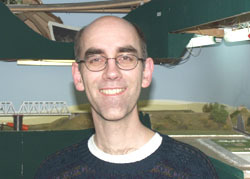
John Socha is the person who coined the term "screen saver." And maybe even created the first screensaver. Actually in its infancy, the screensaver (night sky with stars) was the second hallmark of Norton Commander 3.0 along with two blue background panels. This screen saver was called the classic DOS screensaver and was associated not with Norton, but with DOS. In 2001, Joe Forster wrote Starry Night, which faithfully reproduces the classic Norton Commander screensaver. You can download and try it.
The first years of the development of Norton Commander (1984-1988) were the years of triumphal ascension of MS-DOS, as the most widespread operating system on the planet. She quickly changed CP / M, and since the end of 1983 the tide has been “raising many boats”: many software products created for MS-DOS have become dominant in their class and even served as the de facto standard for porting to other OSs. And this is not limited to working with spreadsheets, word processors, computer games. Utilities have also been a fast-growing area. Crazy, stressful area. People experiencing tremendous pressure, the atmosphere of startups ... Many of them are already half-forgotten or completely forgotten. But this was the first software whose “gold rush” was later replayed in dot-com in a slightly different manner.
The then life of superheroes of the DOS revolution and the subsequent "gold rush" of rivals is better than science fiction. Now such an intense atmosphere can only be found if in gaming companies. They did not invent anything new in software, but they had a unique ability to develop high-quality software, along with the ability to enter the market with a product, gradually make it better so that it would become successful, creating a profitable business. The most successful of them had a unique combination of the qualities of a software developer, a deep understanding of the market, characteristic of a stock broker.
Personal computers began selling in the late 70s. DOS was almost empty at that time, with software in its infancy. Using IBM mainframe software was very expensive (an hour cost about $ 70). And this situation has changed forever with the launch of DOS. The personal computer and the corresponding software for DOS represents an uprising against the established foundations, and the first DOS software entrepreneurs in this sense were revolutionaries who broke the old order. You can read more about this period in Bill Gates’s Hard Drive and in the Microsoft Empire by James Walls and Jim Erickson, published in 1993, when the memory of this period has not yet dissipated.
All the early players in this new industry were like Swiss knives in terms of personalities. They were able to work long hours as programmers and at the same time be excellent technical managers and architects. The atmosphere of the rat race of many startups was well described in Bill Gates' Hard Drive, a book about Microsoft's early years
Therefore, it does not surprise me personally that John Socha later organized several successful startups. As one famous athlete once said: “the more I practice, the more lucky I become.” And this applies to all successful entrepreneurs of that period. These startups hired bright programmers who were supposed to work devastatingly long hours, with minimal control, but at the same time as a team. And those who won were better and smarter. They sold high quality products at lower prices to customers. Most of these early DOS software entrepreneurs will be equally successful in other areas. They just happened to be in the right place at the right time and managed to push through the "solid core" of the business in order to survive, outsmart competitors about to flourish. Peter Norton turned an investment of less than $ 50,000 in 1982 into $ 70,000,000 in 1991 when he sold the company. However, he was of course a small player. Indeed, in 1995 he received 5 million, while Microsoft received in 1995 140.
It is interesting to note that initially Norton Commander had a strong rival, a rival ahead of them with the release of version 1.0 and who dominated all reviews for another five years.
Here's how Jeff Johnson recalled the events that led to the launch of XTree in April 1985 (XTree was launched a year before Norton Commander):
A few months later, we had hundreds of floppy disks and several hard drives jam-packed with files. And we had no idea where what is. We had no way to manage these files at least somehow, and this is where my story begins.
As you can see, there was no way to manage the files. At least there wasn’t a simple enough way to do this: there wasn’t a single utility for this task. There were utilities for CP / M that were written by our friend Mike Karas, which we used. And some console-oriented programs. But not one of them was aimed at managing the directory structure.
It made us all take a deep breath ...
So we started thinking about it, started talking to each other about it. We shouted at each other because of this and threatened each other with ancient Klingor curses. In other words, we sat down as adults and began to reason.
We discussed various types of tree structures, their recursive processing, and other technical issues. Drawings and diagrams came and went, as did the bin in the kitchen.
Among the ideas discussed were, for example, such as how the program will present the DOS directory structure and how the program will display them on the screen. I drew this on the board. It was like a tree that needs water ( apparently, it means that it grows sideways and lies on the ground, approx. Transl. ). But no one believed that this could be done. “Impossible,” they said.
Famous, last words.
I went home on Friday and programmed like crazy until Sunday, after which I showed Harry the result on Monday. A week later, we decided to try to display the tree in the backup program that we wrote for Epson. They liked it. We had the rudiments of our own product.
In December 1984, we started over what you know as XTree. Our todo list on TODO was huge and many of the desired features never made it to the release. However, they were added later in XTree and XTree Pro Gold. I worked full time on the program, while Ken worked on it between the rest of the tasks. When the program was written enough to use it, we started using it. We felt that if other people rely on it, it should be easy to learn and full of functions to help in the work.
If this does not seem obvious to you, I do not want you to think that some crazy genius did everything himself. Everything is far from it. Every time you try to do something that no one has done before, a lot of people participate in it.
So it was with XTree. Dale was in control of features that were part of the product. To make it explosive as far as possible. Henry controlled that we did not write bad code. Tom controlled us to make a user-friendly interface (its tireless work ensured consistency in the product interface. And it was really appreciated by hundreds and millions of users. Every time we thought that XTree was ready, Tom always pointed out that it was possible to refine it ) And finally, Ken. He was a great tester.
In the end, all that remains to be done is to come up with a name.
For many months, sitting in the office, we came up with many names, but could not agree. And one night, my wife offered XTree. “X-Tree ... X-Tree ... read about it!”
Pretty stupid, as it seemed to me at the beginning, but I still wrote it down to myself.
When I got to the office, I told everyone about it and everyone answered me: “somehow silly”, but we left the name.
Well, now we had a name, there was a program, and we had a problem: how can we drag it to stores so that people like you could buy it, and we could make $ * billion on this? At that time, we had only two options: we could publish it ourselves, or we could find someone who knew more about this issue than we did: and in 1985 there were not many people who understood at least something on this issue .
On March 1, 1985, we decided to publish XTree on our own. At the time of insanity and being at the West Coast Computer Faire in San Francisco, Dale claimed responsibility and promised that XTree would be completely ready.
All manuals are written, printed and that all hundreds of details that could only be completely ready within 30 days. As it seemed then, we took on an unbearable burden and World Fool's Day was a great choice for our premiere.
The only thing we did not know was that Dave had an ace up his sleeve: Michael Cahlin, president of Cahlin / Williams Communications.
Over the next four weeks, Kakhlin had a finished product, packaging design, printed materials, press materials for publications. The first XTree brochure, “Read All About XTree.” And along with Dale Saynor and Judy Mason, a stand was set up on the shore of the West Coast Computer Faire.
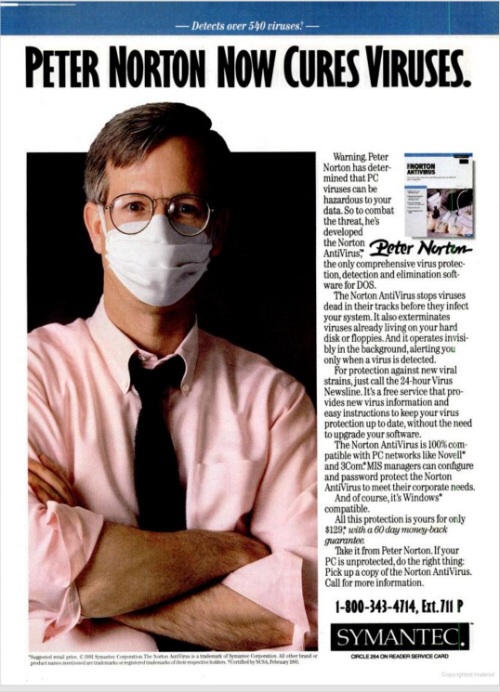
Due to the immense popularity of Norton Commander, he has had a great cultural influence. First of all, the word Norton has become synonymous with a good file manager. He also spawned a huge number of humorous stories:
“Comrades, we must abandon the false values instilled in our enemies! The fact that a Windows GUI user is happier than a command line user is like a drunk happier sober "
About the incompatibility of Norton Commander and alcohol:
Drunk programmer sits with open Norton Commander on the screen. On both panels, drive C is open. “Well, why do I need two drive C with the same files?” He thought and erased all its contents by pressing F8 and Enter.
And this is a record of one of the newcomers to a quiz organized by me at a laboratory at the Kiev University of Economics and Commerce (which at that time replaced all copies of Norton Commander with Volkov Commander in 1992-1994):
Q: What is the name of the operating system in which you performed the task?
A: Volkov Commander.
All Articles